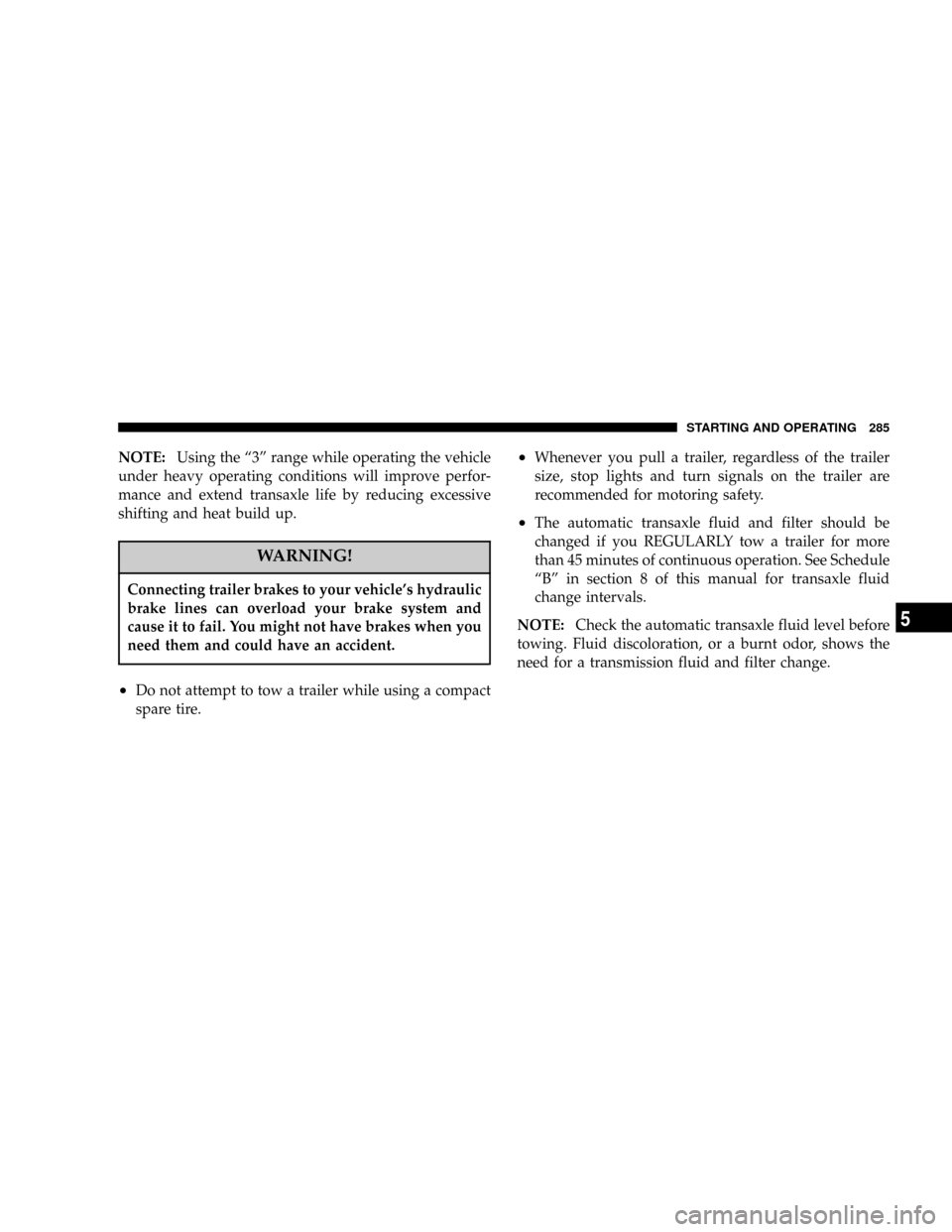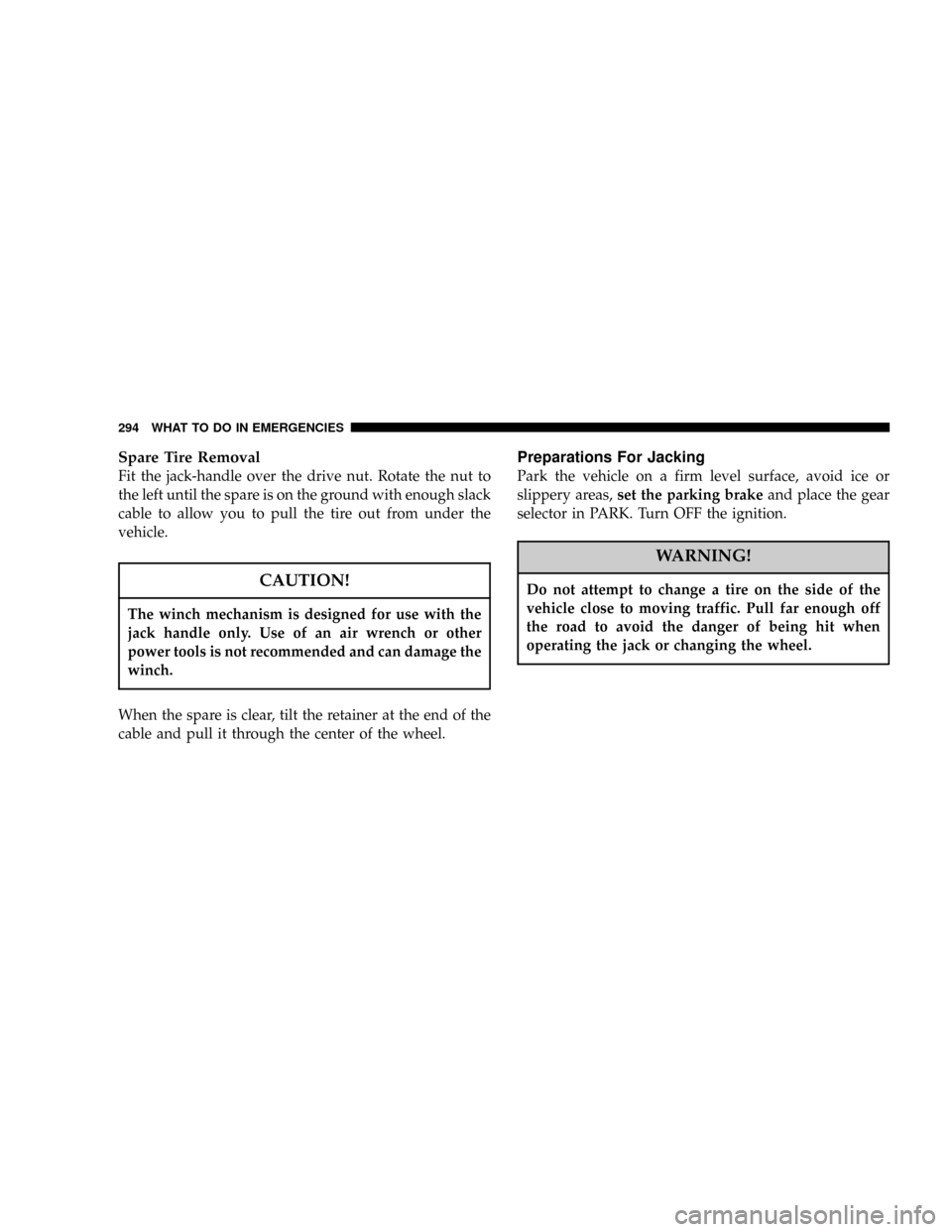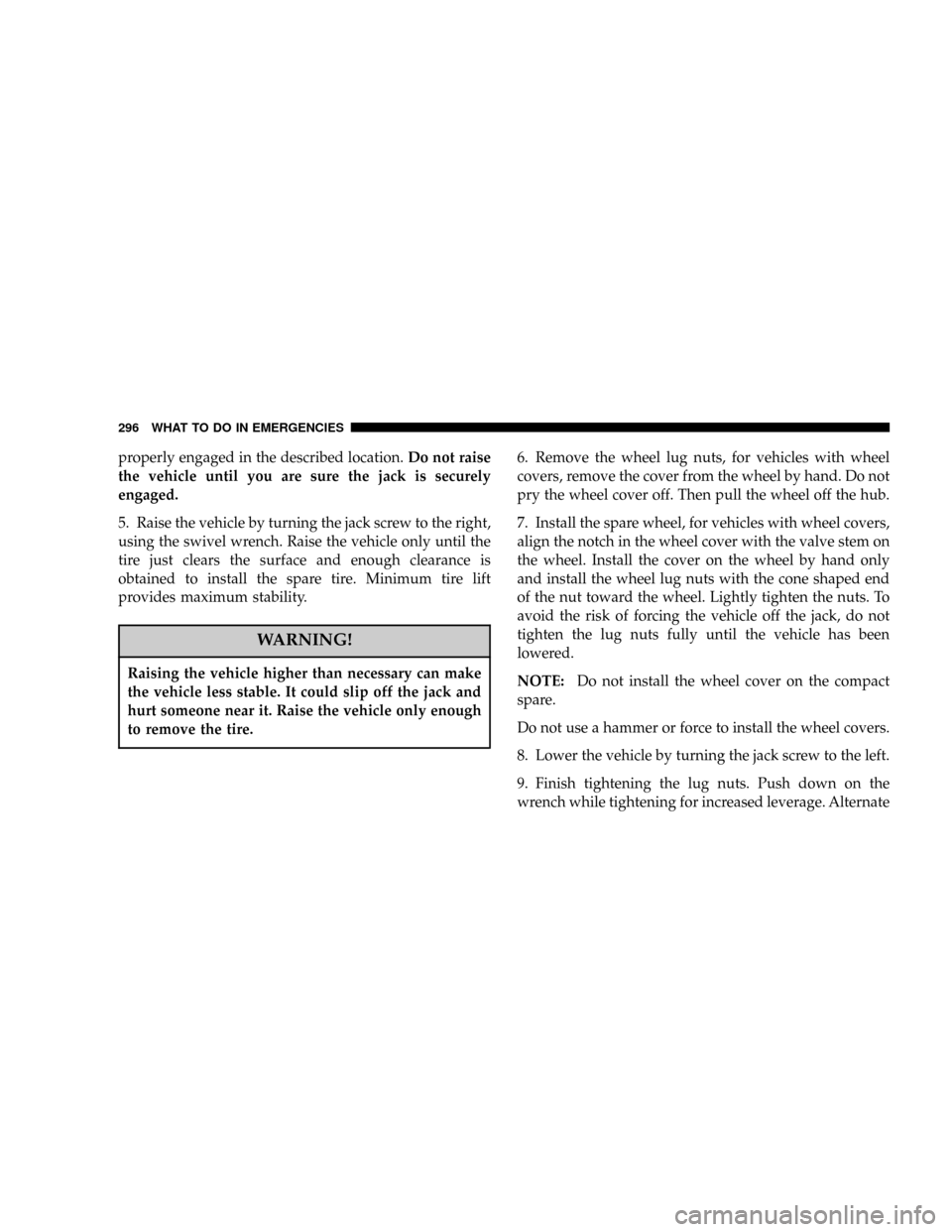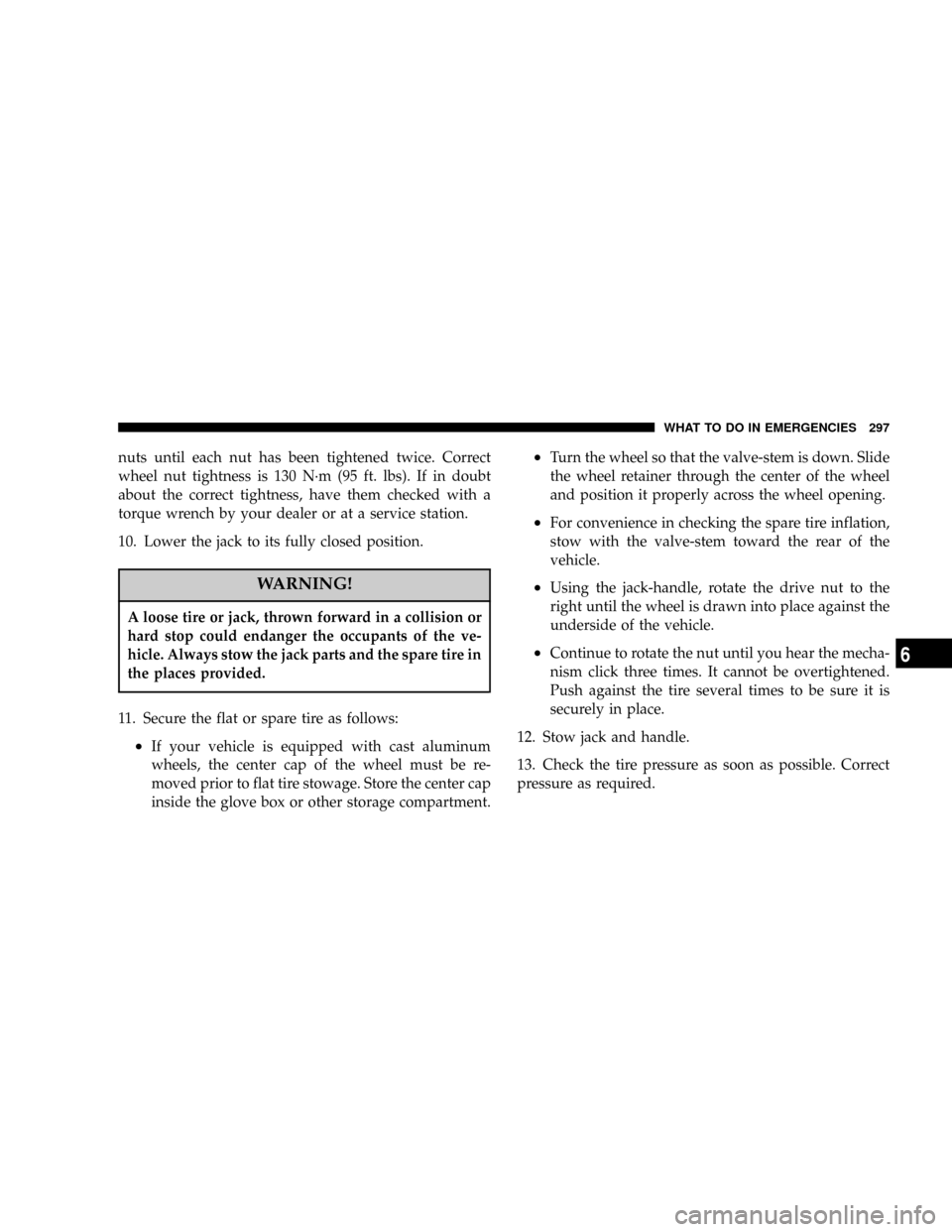spare tire CHRYSLER TOWN AND COUNTRY 2004 4.G User Guide
[x] Cancel search | Manufacturer: CHRYSLER, Model Year: 2004, Model line: TOWN AND COUNTRY, Model: CHRYSLER TOWN AND COUNTRY 2004 4.GPages: 401
Page 270 of 401

TIRE PRESSURE NOW AVAILABLE
The TPM system is functioning normally and the external
interference is no longer affecting the system.
SPARE TIRE IN USE? YES/NO
The TPM system requires more information to determine
the correct mode of operation, one or more of the vehicle
active tires has been replaced by the spare, a wheel rim
not equipped with a TPM sensor or the TPM system
requires service.
If the spare tire or non TPM sensor equipped wheel rim
is in active use (mounted on the vehicle), answer YES and
the TPM system will resume normal operation.
If the spare tire or non TPM sensor equipped wheel rim
isNOTin active use (mounted on the vehicle), answer
NO and the TPM system will resume normal operation.
ALL 5 TIRES WITH CAR? YES/NO
The TPM system requires more information to determine
the correct mode of operation, one or more of the vehicle
active tires has been replaced by the spare, a wheel rim
not equipped with a TPM sensor or the TPM system
requires service.
If the spare tire or non TPM sensor equipped wheel rim
is in active use (mounted on the vehicle), answer YES and
the TPM system will resume normal operation.
If the spare tire or non TPM sensor equipped wheel rim
isNOTin active use (mounted on the vehicle), answer
NO and the TPM system will resume normal operation.
270 STARTING AND OPERATING
Page 272 of 401

General Information
This device complies with part 15 of the FCC rules and
RSS 210 of Industry Canada. Operation is subject to the
following conditions:
²This device may not cause harmful interference.
²This device must accept any interference received,
including interference that may cause undesired op-
eration.
The tire pressure sensors are covered under one of the
following licenses:
United States.....................KR5S120123
Canada........................2671-S120123
TIRE CHAINS
Use only compact chains, or other traction aids that meet
SAE type ªClass Sº specifications. Chains must be the
proper size for the vehicle, as recommended by the chain
manufacturer.
NOTE:Do not use tire chains on a compact spare tire.
CAUTION!
To avoid damage to your vehicle or tires, observe the following
precautions:
²Because of restricted chain clearance between tires and
other suspension components, it is important that only
chains in good condition are used. Broken chains can cause
serious damage. Stop the vehicle immediately if noise
occurs that could indicate chain breakage. Remove the
damaged parts of the chain before further use.
²Install chains on the front wheels as tightly as possible and
then retighten after driving about1¤2mile (0.8 km).²Do not exceed 45 mph (70 km/h).
²Drive cautiously and avoid severe turns and large
bumps, especially with a loaded vehicle.
²Do not use on rear wheels of All Wheel Drive (AWD)
vehicles.
²Do not drive for prolonged period on dry pavement.
²Observe the tire chain manufacturer's instructions on the
method of installation, operating speed, and conditions for
use. Always use the lower suggested operating speed of the
chain manufacturer if different than the speed recom-
mended by the manufacture.
272 STARTING AND OPERATING
Page 285 of 401

NOTE:Using the ª3º range while operating the vehicle
under heavy operating conditions will improve perfor-
mance and extend transaxle life by reducing excessive
shifting and heat build up.
WARNING!
Connecting trailer brakes to your vehicle's hydraulic
brake lines can overload your brake system and
cause it to fail. You might not have brakes when you
need them and could have an accident.
²Do not attempt to tow a trailer while using a compact
spare tire.
²Whenever you pull a trailer, regardless of the trailer
size, stop lights and turn signals on the trailer are
recommended for motoring safety.
²The automatic transaxle fluid and filter should be
changed if you REGULARLY tow a trailer for more
than 45 minutes of continuous operation. See Schedule
ªBº in section 8 of this manual for transaxle fluid
change intervals.
NOTE:Check the automatic transaxle fluid level before
towing. Fluid discoloration, or a burnt odor, shows the
need for a transmission fluid and filter change.
STARTING AND OPERATING 285
5
Page 289 of 401

WHAT TO DO IN EMERGENCIES
CONTENTS
mHazard Warning Flasher..................290
mIf Your Engine Overheats.................291
mJacking And Tire Changing................292
NJack Location........................293
NSpare Tire Stowage....................293
NPreparations For Jacking................294
NJacking Instructions....................295
mJump-Starting Procedures If Battery Is Low....298
mDriving On Slippery Surfaces..............299
NAcceleration.........................299NTraction............................300
mFreeing A Stuck Vehicle..................300
mTowing A Disabled Vehicle................301
NWith Ignition Key.....................301
NWithout The Ignition Key...............302
NTowing This Vehicle Behind Another Vehicle
(Flat Towing With All Four Wheels On The
Ground)............................302
NTowing This Vehicle Behind Another Vehicle
With A Tow Dolley....................303
6
Page 293 of 401

Jack Location
The jack and jack-handle are stowed behind the rear left
side trim panel in the cargo area. Pull up on the lever to
release the cover.
Spare Tire Stowage
The spare tire is stowed under the rear of the vehicle by
means of a cable winch mechanism. To remove or stow
the spare, use the jack handle to rotate the ªspare tire
driveº nut. The nut is located under the plastic cover at
the center-rear of the cargo floor area, just inside the
liftgate opening.
WHAT TO DO IN EMERGENCIES 293
6
Page 294 of 401

Spare Tire Removal
Fit the jack-handle over the drive nut. Rotate the nut to
the left until the spare is on the ground with enough slack
cable to allow you to pull the tire out from under the
vehicle.
CAUTION!
The winch mechanism is designed for use with the
jack handle only. Use of an air wrench or other
power tools is not recommended and can damage the
winch.
When the spare is clear, tilt the retainer at the end of the
cable and pull it through the center of the wheel.
Preparations For Jacking
Park the vehicle on a firm level surface, avoid ice or
slippery areas,set the parking brakeand place the gear
selector in PARK. Turn OFF the ignition.
WARNING!
Do not attempt to change a tire on the side of the
vehicle close to moving traffic. Pull far enough off
the road to avoid the danger of being hit when
operating the jack or changing the wheel.
294 WHAT TO DO IN EMERGENCIES
Page 295 of 401

²Turn on the Hazard Warning Flasher.
²Block both the front and rear
of the wheel diagonally oppo-
site the jacking position. For
example, if changing the right
front tire, block the left rear
wheel.
²Passengers should not remain in the vehicle when the
vehicle is being jacked.
Jacking Instructions
1. Remove the spare wheel, scissors jack and jack-handle
from stowage.
2. Loosen (but do not remove) the wheel lug nuts by
turning them to the left one turn while the wheel is still
on the ground.3. There are two jack engagement locations on each side
of the body Ð see illustration.
4. These locations are on the sill flange of the body and
consist of a pair of downstanding tabs. The jack is to be
located, engaging the flange, between the pair of tabs
closest to the wheel to be changed. Place the wrench on
the jack screw and turn to the right until the jack head is
WHAT TO DO IN EMERGENCIES 295
6
Page 296 of 401

properly engaged in the described location.Do not raise
the vehicle until you are sure the jack is securely
engaged.
5. Raise the vehicle by turning the jack screw to the right,
using the swivel wrench. Raise the vehicle only until the
tire just clears the surface and enough clearance is
obtained to install the spare tire. Minimum tire lift
provides maximum stability.
WARNING!
Raising the vehicle higher than necessary can make
the vehicle less stable. It could slip off the jack and
hurt someone near it. Raise the vehicle only enough
to remove the tire.
6. Remove the wheel lug nuts, for vehicles with wheel
covers, remove the cover from the wheel by hand. Do not
pry the wheel cover off. Then pull the wheel off the hub.
7. Install the spare wheel, for vehicles with wheel covers,
align the notch in the wheel cover with the valve stem on
the wheel. Install the cover on the wheel by hand only
and install the wheel lug nuts with the cone shaped end
of the nut toward the wheel. Lightly tighten the nuts. To
avoid the risk of forcing the vehicle off the jack, do not
tighten the lug nuts fully until the vehicle has been
lowered.
NOTE:Do not install the wheel cover on the compact
spare.
Do not use a hammer or force to install the wheel covers.
8. Lower the vehicle by turning the jack screw to the left.
9. Finish tightening the lug nuts. Push down on the
wrench while tightening for increased leverage. Alternate
296 WHAT TO DO IN EMERGENCIES
Page 297 of 401

nuts until each nut has been tightened twice. Correct
wheel nut tightness is 130 N´m (95 ft. lbs). If in doubt
about the correct tightness, have them checked with a
torque wrench by your dealer or at a service station.
10. Lower the jack to its fully closed position.
WARNING!
A loose tire or jack, thrown forward in a collision or
hard stop could endanger the occupants of the ve-
hicle. Always stow the jack parts and the spare tire in
the places provided.
11. Secure the flat or spare tire as follows:
²If your vehicle is equipped with cast aluminum
wheels, the center cap of the wheel must be re-
moved prior to flat tire stowage. Store the center cap
inside the glove box or other storage compartment.
²Turn the wheel so that the valve-stem is down. Slide
the wheel retainer through the center of the wheel
and position it properly across the wheel opening.
²For convenience in checking the spare tire inflation,
stow with the valve-stem toward the rear of the
vehicle.
²Using the jack-handle, rotate the drive nut to the
right until the wheel is drawn into place against the
underside of the vehicle.
²Continue to rotate the nut until you hear the mecha-
nism click three times. It cannot be overtightened.
Push against the tire several times to be sure it is
securely in place.
12. Stow jack and handle.
13. Check the tire pressure as soon as possible. Correct
pressure as required.
WHAT TO DO IN EMERGENCIES 297
6
Page 388 of 401

Cargo Compartment
Luggage Carrier....................... 149
Cassette Tape and Player Maintenance......... 207
Cassette Tape Player..................... 171
Catalytic Converter...................... 318
CD Changer......................179,192,197
CD Player...............177,181,183,188,191,197
Center High Mounted Stop Light............ 351
Center Lap Belts......................... 48
Chains, Tire............................ 272
Changing A Flat Tire..................... 292
Child Restraint.......................... 59
Child Restraint Tether Anchors............... 64
Child Safety Locks........................ 32
Child Seat............................59,66
Clean Air Gasoline....................... 275
Climate Control......................... 209
Clock................................ 169
Compact Disc Maintenance................. 208Compact Disc Player..................171,177
Compact Spare Tire...................... 264
Compass.............................. 121
Compass Calibration..................... 122
Compass Variance....................... 122
Computer, Trip/Travel.................... 124
Console, Overhead....................... 120
Console, Removable...................... 142
Contract, Service........................ 378
Coolant Pressure Cap..................... 329
Cooling System......................... 326
Adding Coolant (Antifreeze).............. 328
Coolant Capacity...................... 351
Coolant Level......................... 329
Disposal of Used Coolant................ 329
Drain, Flush, and Refill.................. 327
Inspection........................... 326
Points to Remember.................... 330
Pressure Cap......................... 329
388 INDEX